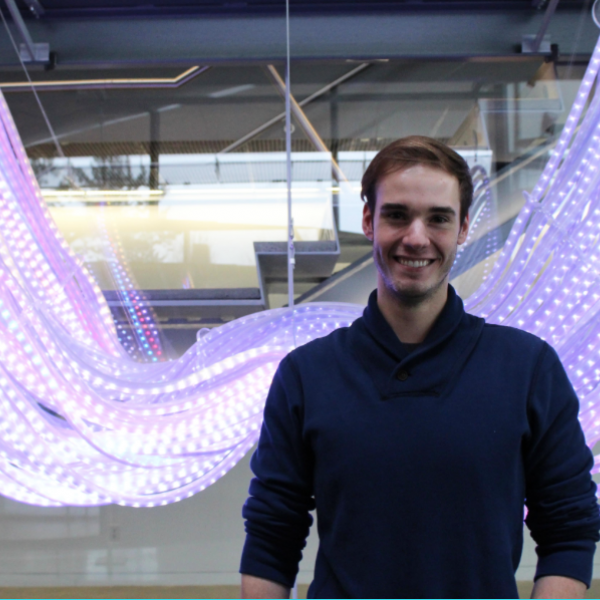by Louis DiPietro
In the Gates Hall atrium, the illuminated, interactive art installation known as the Mood Cloud typically displays a diverse palette of colors based on users who plug their emotions into the cloud’s iPad interface. This semester, though, the Mood Cloud has shown particularly blue (and purple), but, take heed, that’s not an indication of a gloomy campus. Rather, it’s the product of Info Sci senior Colin Budd’s hacking skills.
With the okay from his professors, Budd programmed the Mood Cloud, which was originally developed by Cornell’s Interaction Design Lab, to pull online weather information from data points on the Cornell campus. Those blues and purples you see correspond to outside brightness and temperature – the more vibrant the sky, the brighter the Mood Cloud – and that wavy light effect is tied to wind speeds.
“It takes a snapshot of all the weather data and applies a color to the number,” the Pittsburgh native said.
Why weather?
“From my background in Fine Art at Cornell, I’ve come to appreciate the importance of ‘situating pieces’ in order to better connect a work to its surrounding environment,” he said. “What better way to situate the work than have it respond to the very element we as Cornellians deal with on a daily basis: the ever-changing weather. The next challenge was to understand the best means of displaying weather information within the existing framework.”
Budd’s latest fusion of art and technology began last semester, during an independent art study course in Cornell’s school of Architecture, Art and Planning. There, he discovered Processing, the coding language built for arts and visual design.
“I read every book on it,” he said.
And it so happens that the Mood Cloud itself is coded in Processing, a point relayed from one of his professors, David Mimno, who encouraged Budd to hack away.
Mood Cloud pulls online data from the weather station atop Cornell’s Olive Tjaden Hall and adjusts its luminosity based on sunset, sunrise, temperature, current conditions, humidity and wind speed. Perhaps most impressive is Budd’s ingenuity in linking the day’s sky color to the Cloud. For that, Budd programmed the piece to pull a cropped, photo still of the sky from the Barnes Hall rooftop live cam. On an overcast day, Mood Cloud’s bluish hint is more subtle, but vibrant during sunny afternoons.
As warmer Ithaca weather approaches, Budd said, look for the Mood Cloud to respond in a much more dynamic way.
The piece will continue pulling weather data through the spring semester.



